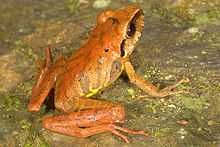Eleutherodactylidae
| Eleutherodactylidae | |
|---|---|
 | |
| Eleutherodactylus danae | |
| Scientific classification | |
| Kingdom: | Animalia |
| Phylum: | Chordata |
| Class: | Amphibia |
| Order: | Anura |
| Family: | Eleutherodactylidae |
| Subfamilia | |
|
Eleutherodactylinae | |
| Synonyms | |
|
Eleutherodactylinae Lutz, 1954 | |
The Eleutherodactylidae are a family of direct-developing frogs native to northern South America, the Caribbean, and southernmost North America. They are sometimes known under common name rain frogs.[1][2] Formerly a subfamily Eleutherodactylinae of the Leptodactylidae family, it was raised to the family status following a major revision of New World direct-developing frogs in 2008.[3][1] As currently defined, the family has more than 200 species (as of 2014, 206[1] or 207[2] species).
Eleutherodactylid frogs vary considerably in size, from the minuscule Eleutherodactylus iberia (female snout–vent length 10.5 mm (0.41 in)) to the relative giant Eleutherodactylus inoptatus (female snout–vent length 88 mm (3.5 in)).[2] Except for the ovoviviparous Eleutherodactylus jasperi, these frogs have direct development: no free-living tadpole stage exists; instead, eggs develop directly into small froglets.[3]
Subfamilies and genera
The two subfamilies and four genera are:[1][2]
- Eleutherodactylinae Lutz, 1954 (197 species)
- Diasporus Hedges, Duellman, and Heinicke, 2008
- Eleutherodactylus Duméril and Bibron, 1841
- Phyzelaphryninae Hedges, Duellman, and Heinicke, 2008 (9 species)
- Adelophryne Hoogmoed and Lescure, 1984
- Phyzelaphryne Heyer, 1977
References
- ↑ 1.0 1.1 1.2 1.3 Frost, Darrel R. (2014). "Eleutherodactylidae Lutz, 1954". Amphibian Species of the World: an Online Reference. Version 6.0. American Museum of Natural History. Retrieved 24 April 2014.
- ↑ 2.0 2.1 2.2 2.3 "Eleutherodactylidae". AmphibiaWeb: Information on amphibian biology and conservation. [web application]. Berkeley, California: AmphibiaWeb. 2014. Retrieved 24 April 2014.
- ↑ 3.0 3.1 Hedges, S. B., Duellman, W. E., and Heinicke, M. P (2008). "New World direct-developing frogs (Anura: Terrarana): Molecular phylogeny, classification, biogeography, and conservation". Zootaxa 1737: 1–182.
External links
 Media related to Eleutherodactylinae at Wikimedia Commons
Media related to Eleutherodactylinae at Wikimedia Commons
| |||||||||||||||||||||